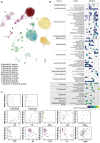Geology defines microbiome structure and composition in nunataks and valleys of the Sør Rondane Mountains, East Antarctica
- PMID: 38380088
- PMCID: PMC10877063
- DOI: 10.3389/fmicb.2024.1316633
Geology defines microbiome structure and composition in nunataks and valleys of the Sør Rondane Mountains, East Antarctica
Abstract
Understanding the relation between terrestrial microorganisms and edaphic factors in the Antarctic can provide insights into their potential response to environmental changes. Here we examined the composition of bacterial and micro-eukaryotic communities using amplicon sequencing of rRNA genes in 105 soil samples from the Sør Rondane Mountains (East Antarctica), differing in bedrock or substrate type and associated physicochemical conditions. Although the two most widespread taxa (Acidobacteriota and Chlorophyta) were relatively abundant in each sample, multivariate analysis and co-occurrence networks revealed pronounced differences in community structure depending on substrate type. In moraine substrates, Actinomycetota and Cercozoa were the most abundant bacterial and eukaryotic phyla, whereas on gneiss, granite and marble substrates, Cyanobacteriota and Metazoa were the dominant bacterial and eukaryotic taxa. However, at lower taxonomic level, a distinct differentiation was observed within the Cyanobacteriota phylum depending on substrate type, with granite being dominated by the Nostocaceae family and marble by the Chroococcidiopsaceae family. Surprisingly, metazoans were relatively abundant according to the 18S rRNA dataset, even in samples from the most arid sites, such as moraines in Austkampane and Widerøefjellet ("Dry Valley"). Overall, our study shows that different substrate types support distinct microbial communities, and that mineral soil diversity is a major determinant of terrestrial microbial diversity in inland Antarctic nunataks and valleys.
Keywords: Antarctica; bacteria; bedrock; eukaryotes; metabarcoding; microbial ecology; rRNA.
Copyright © 2024 Savaglia, Lambrechts, Tytgat, Vanhellemont, Elster, Willems, Wilmotte, Verleyen and Vyverman.
Conflict of interest statement
The authors declare that the research was conducted in the absence of any commercial or financial relationships that could be construed as a potential conflict of interest. The author(s) declared that they were an editorial board member of Frontiers, at the time of submission. This had no impact on the peer review process and the final decision.
Figures





Similar articles
-
Bacterial community composition in relation to bedrock type and macrobiota in soils from the Sør Rondane Mountains, East Antarctica.FEMS Microbiol Ecol. 2016 Sep;92(9):fiw126. doi: 10.1093/femsec/fiw126. Epub 2016 Jul 10. FEMS Microbiol Ecol. 2016. PMID: 27402710
-
Bacterial and eukaryotic biodiversity patterns in terrestrial and aquatic habitats in the Sør Rondane Mountains, Dronning Maud Land, East Antarctica.FEMS Microbiol Ecol. 2016 Jun;92(6):fiw041. doi: 10.1093/femsec/fiw041. Epub 2016 Mar 2. FEMS Microbiol Ecol. 2016. PMID: 26936447
-
Microbial community composition of terrestrial habitats in East Antarctica with a focus on microphototrophs.Front Microbiol. 2024 Jan 5;14:1323148. doi: 10.3389/fmicb.2023.1323148. eCollection 2023. Front Microbiol. 2024. PMID: 38249463 Free PMC article.
-
Cyanobacteria inhabiting biological soil crusts of a polar desert: Sør Rondane Mountains, Antarctica.Syst Appl Microbiol. 2018 Jul;41(4):363-373. doi: 10.1016/j.syapm.2018.01.006. Epub 2018 Feb 7. Syst Appl Microbiol. 2018. PMID: 29452715
-
Gullies and Moraines Are Islands of Biodiversity in an Arid, Mountain Landscape, Asgard Range, Antarctica.Front Microbiol. 2021 Jun 10;12:654135. doi: 10.3389/fmicb.2021.654135. eCollection 2021. Front Microbiol. 2021. PMID: 34177836 Free PMC article.
Cited by
-
The Establishment of a Terrestrial Macroalga Canopy Impacts Microbial Soil Communities in Antarctica.Microb Ecol. 2025 Feb 13;88(1):4. doi: 10.1007/s00248-025-02501-8. Microb Ecol. 2025. PMID: 39945839 Free PMC article.
References
-
- Andrews S. (2010). FastQC: a quality control tool for high throughput sequence data [online].
-
- Archer S. D. J., de los Ríos A., Lee K. C., Niederberger T. S., Cary S. C., Coyne K. J., et al. . (2016). Endolithic microbial diversity in sandstone and granite from the McMurdo dry valleys, Antarctica. Polar Biol. 40, 997–1006. doi: 10.1007/s00300-016-2024-9 - DOI
-
- Artois T., Fontaneto D., Hummon W. D., McInnes S. J., Todaro M. A., Sørensen M. V., et al. . (2011). “Ubiquity of microscopic animals? Evidence from the morphological approach in species identification” in Biogeography of microscopic organisms: Is everything small everywhere. ed. Fontaneto D. (Cambridge: Cambridge University Press; ), 245–249.
LinkOut - more resources
Full Text Sources

